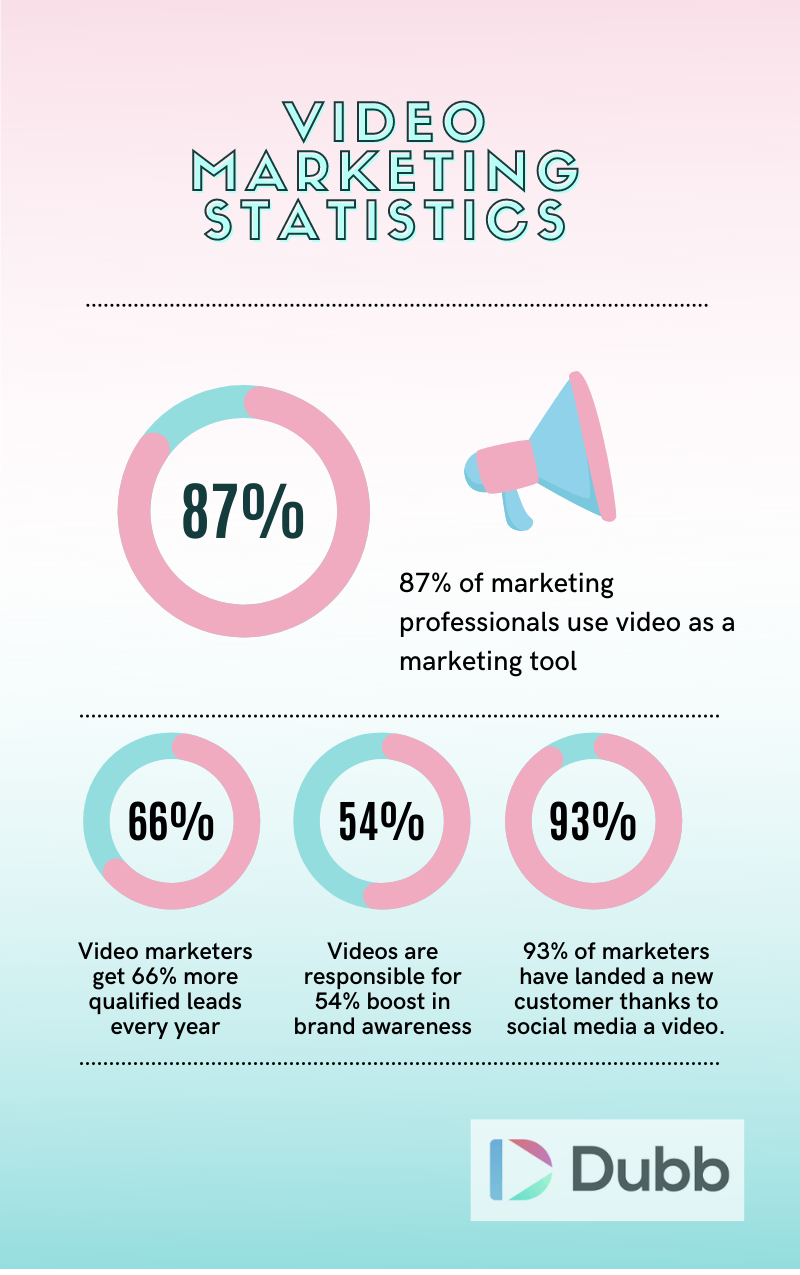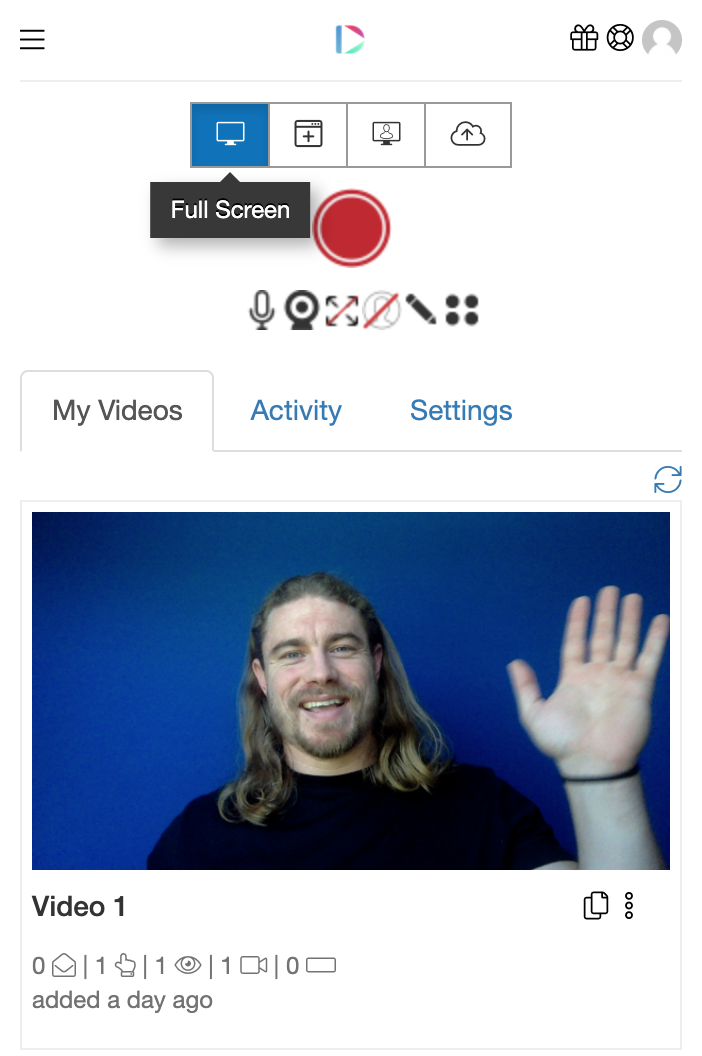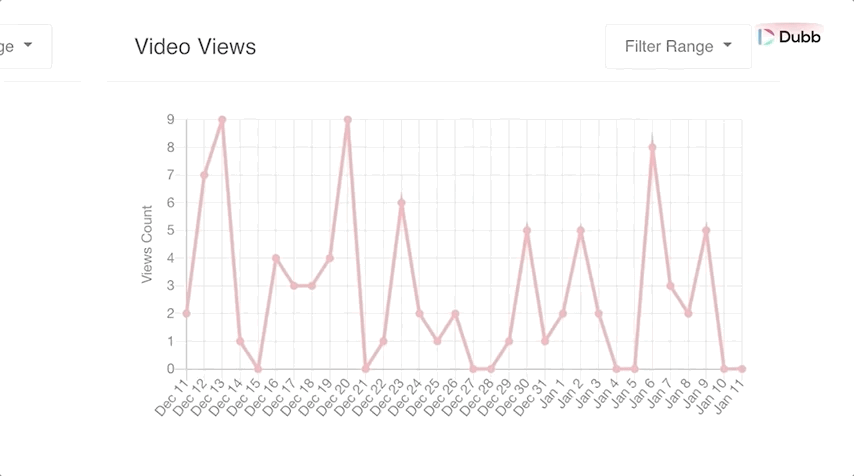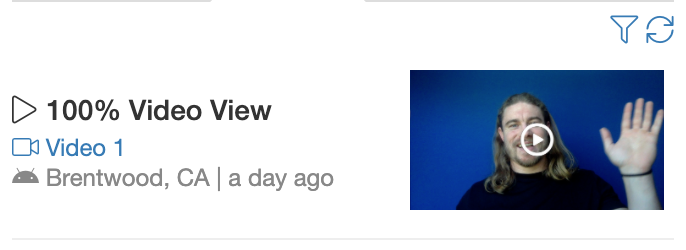You’ve most likely heard it a couple of times — “Videos are taking over.”
They’re being shared everywhere; Facebook, Instagram, TikTok, and almost every social platform you can think of. This trend isn’t limited to regular social media though, businesses are hopping on too. B2B video marketing is growing rapidly. In fact, more businesses — ranging from small startups to large enterprises — are now using videos to improve their marketing and sales efforts.
Still, it seems not everyone has gotten on the train yet.
There are still businesses that are dragging their feet when it comes to video marketing for several reasons. As we’ll see, these reasons that are holding them back are false and just misconceptions.
In this article, we’ll go over the importance of videos in marketing and sales, and the common false beliefs that stop businesses from taking action.
Why are videos important for marketing and sales?
Before we dive into the list, why are videos so important?
What’s all the hype around videos, anyways?
Well, the short answer to that question is that videos are powerful and generate massive results for sales and marketing (both online and offline). And here are some cold, hard statistics to prove it;

A recent report by Wyzowl shows that as of 2021, 86% of marketing professionals use video as a marketing tool.
Also, according to Optinmonster, video marketers get 66% more qualified leads every year and up to 54% boost in brand awareness. Additionally, 93% of marketers say they’ve landed a new customer thanks to a video on social media.
We could go on and on, but these stats just drive home the point. Videos are essential for marketing and they’re effective.
That being said, let’s talk about some common B2B video marketing myths;
1. B2B Video Marketing is Expensive
$15,000,000.
That’s roughly how much Amazon paid for a 90-second commercial during the 2018 Superbowl. It’s an insane amount of money that most businesses cannot budget for marketing, let alone for videos exclusively. And thankfully, you don’t need to.
One of the common reasons businesses have for not incorporating videos in their marketing and sales strategy is the perceived cost. There’s the false belief that good videos cost a lot of money to produce.
But most companies spend less than 10% of their marketing budget on videos — yet, 8 out of 10 marketers say video has helped them generate leads.
Nowadays, it’s possible to create high-quality videos that actually get results — using free or inexpensive tools. For starters, your iPhone has a pretty decent camera, so you might not have to invest in expensive gear while starting out.
There are also a ton of free screen recorders out there (even though some have limitations). But with Dubb, you’ll get a suite of creation tools to help you record and edit high-quality webcam or screen videos on a budget.

By creating videos and putting the content out there, you’re effectively cloning yourself. And when your prospects watch, it’s the next best thing to seeing you. So you’re minimizing input and getting maximum output.
When you compare the benefits of using videos in your marketing to the minimal cost of producing them, it’s clear that you cannot afford not to do videos.
2. We Don’t Have Time to Create Videos
Time is money, right?
True. We all have 8 hours each day to get a ton of things done, but it seems like it’s just not enough. So it’s important to focus on tasks we can complete within a short period of time — and for most businesses, shooting complex videos isn’t one of those things.
It’s understandable to think that videos take a lot of time to produce.
But unless you’re shooting a Coca-cola or BMW ad campaign, you don’t need to spend weeks or even days to produce videos.
Thanks to technology, it’s possible to create solid videos within a short period of time. With the Dubb mobile app or Chrome extension, you can record, edit, and share personalized videos in minutes.

In fact, if you speak faster than you type — which most people do — then you can produce a good video in the time it would take to compose a text. So time shouldn’t hold you back from including videos in your marketing.
3. We Need Actors for Our Videos
This is another common myth that stops businesses from creating videos.
While the big sharks have no problem hiring actors (that don’t come cheap, by the way) for videos, small and medium businesses on the other hand can’t afford them. It may seem like a disadvantage but this is not an issue at all.
Businesses don’t need to hire actors. Why?
According to Fast Company, most consumers prefer authenticity to fake stuff. This means that you and your in-house team are in a better position to appear in videos compared to someone else. After all, you know your product better than anyone else. A Third-party will need to be trained, follow a script, learn about your business enough to not make mistakes.

So instead of putting off creating videos because actors aren’t available, consider working with your team to get it done yourself. It’s easier, less expensive, and you’ll get better results. The goal of using videos is to connect with your prospects and customers, so it’s best you keep it real. It’s an opportunity to showcase yourself, your co-workers, and your overall culture.
It’s important to bear in mind that not everyone on your team will be comfortable in front of the camera, though. So try to encourage everyone to be their selves and feel relaxed.
4. We Need a Professional to Produce Video
If you think businesses using videos in their marketing have a team of professional videographers, then think again.
One of the biggest B2B video marketing myths is the idea that you need professionals to get it done. That couldn’t be farther from the truth.
You don’t have to be an expert or have experience before producing high-quality videos. And you certainly don’t need to hire Steven Speilberg either. All you need is your team and the resources you have available.
Yes, it’s nice to keep things neat and decent, but the quality of your videos doesn’t matter as much as the content. If you have something valuable to share, you should share it with your prospects and customers.

Live streams, testimonial videos, and introduction videos are some of the different forms of videos you can produce without hiring a professional. Dubb gives you tools that make the process as easy as possible. You can record, edit, and share videos from any channel — LinkedIn, Gmail, or your CRM — without having video editing skills.
5. We Need a B2B Video Marketing Strategy To Get Started
It’s important to have a plan before you put in time and effort, but most of the time, it takes a while to develop a good one.
One of the reasons businesses put off using videos in their marketing effort is that there’s no strategy for it. But when it comes to marketing, testing rapidly is vital for growth.
Rather than wait till you have a solid strategy before implementing videos, start with a basic idea and scale from there.
We recommend following what is already working already and using videos to improve it. For example, you could record quick videos for your welcome sequence or your outreach campaign for starters.
When you start to get comfortable using videos, you could then set S.M.A.R.T goals. Find a target that is Specific, Measurable, Attainable, Result-oriented, and Time-bound then try to hit it with videos.
The point is, if it isn’t broken, don’t try to fix it. Just get started gradually and improve as you go.
Feel free to go over our complete guide to video marketing, where we dive in-depth and talk about everything you need to start and get better marketing results with videos.
6. We’re B2B. Video Marketing Won’t Work in Our Industry
Most businesses put off using videos because they think it’s not relevant to their industry. But that’s just a false limiting belief.
Instead of assuming that videos aren’t applicable to them, businesses should start asking “what would our customers like to see?” Because at the end of the day, it’s a human being behind the screen, job title, and email thread.
Every business — either B2B, B2C, or D2C — is actually B2H (Business to human). The fact is people want to see more videos and it influences their buying decision. As usual, there are stats to back it up;
- Studies show that 54% of consumers want to see more video content from a brand or business they support
- 73% of consumers claim that they have been influenced by a brand’s social media presence when making a purchasing decision
- And more specifically, nearly eight out of every ten users have purchased a piece of software or app after having watched the brand’s video
The point is videos work.
7. Our Videos Might Not Go Viral
When it comes to video marketing in business, it’s sometimes better to go “unviral” (is that an actual word?), than to go viral.
Believe it or not, one of the reasons businesses aren’t taking advantage of their videos (yet) is they think a lot of people won’t see, like, and comment on the videos. So why put in time and effort to create a video that only a few people will see, right?
Wrong.
The goal shouldn’t be to get a million eyes on your video. Those random people aren’t your prospects. Instead, you should focus on providing value and getting in front of a specific audience — your ideal customers.
When you aren’t using views and likes as a measure of success, you’ll be focused on consistency and cadence — plus you’ll be able to set and manage realistic expectations. Because it’s a matter of quality over quantity. Strive to create videos that are valuable to your audience. This will prompt them to engage with you and move down your funnel.
8. Tracking The ROI of B2B Video Marketing Is Hard
This would have been somewhat true decades ago when brands ran TV commercials with little data to track performance.
These days, technology allows us to track videos at a granular level and correlate them with results.
For businesses serious about their marketing and sales, actionable data is everything, so it’s best to avoid using free hosting platforms. Typically, these platforms will only show the stats like the number of video views, but this isn’t an indication of performance or ROI.
Dubb gives you a ton of ways to share videos — like via LinkedIn, your CRM, or even SMS — and then track important metrics like;
- Who watched a video
- When they watched
- How much of the video they watched
- What actions they took


…and so much more, so you have a clear idea of what is performing well, what isn’t, and the areas to improve.
9. Video is Only Useful For Top of Funnel
A common misconception people have about video marketing is that everything ends at the top of the funnel.
But like Ruben (founder of Dubb) always says, there’s a place for video everywhere along the value path to educate your prospect.
Videos can be used in the entire buyer journey — from initial prospecting down to closing the sale, demo, and testimonial collection.
Here are some areas videos can be applied;
TOFU (Top of the Funnel)
At the top of the funnel, the goal here is lead generation and brand awareness with ads, outreach messages, or lead magnets. Videos play an important role in making a good impression with your prospects because you get to show authenticity.

We’ve seen cases where Dubb users were able to boost outreach response rates by a stunning 300%.
MOFU (Middle of the Funnel)
At this stage, the goal is lead nurturing. Your prospects have heard your offer and are almost in the buying phase.
Businesses typically use videos to lead prospects down the funnel by educating them, plus reinforcing and differentiating their offer. Things like testimonial videos for social proof, competitive videos, and case study walkthroughs are some of the ways videos are used.
BOFU (Bottom of the Funnel)
Even when the prospect buys and beyond, videos can still give solid results.
The goal at this stage is buyer education. And videos can come in handy during demos, onboarding, and support.
So it’s pretty clear videos aren’t restricted to ads and top-of-the-funnel stuff. They can be used everywhere in your marketing funnel and sales process to generate more leads and boost revenue.
What’s Next?
B2B video marketing doesn’t have to be hard or scary.
Every day more businesses are starting to leverage the power of videos to shorten their sales cycle and increase revenue.
And if you haven’t hopped on the train yet, it’s not too late to start. Technology has advanced such that creating, sharing, and tracking videos can be done in a few clicks.
Don’t let myths keep you from creating videos for your marketing and sales efforts. Grab a free trial and use Dubb to start getting better marketing results.

